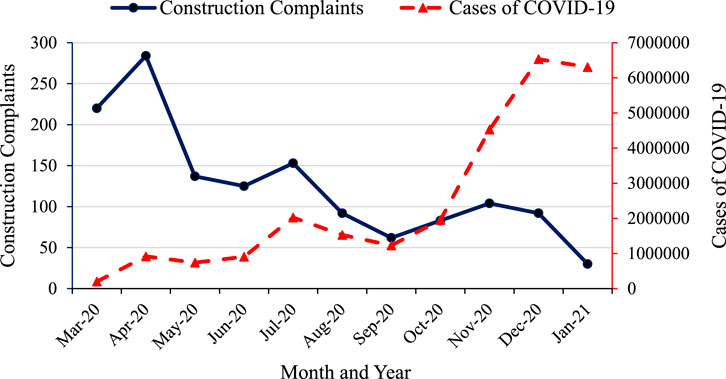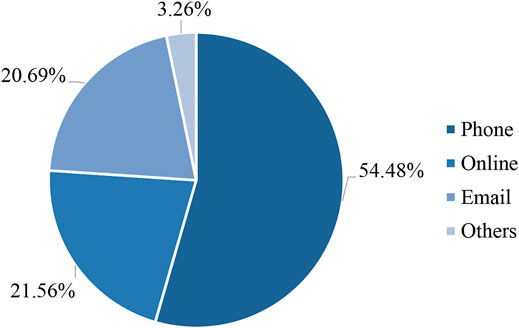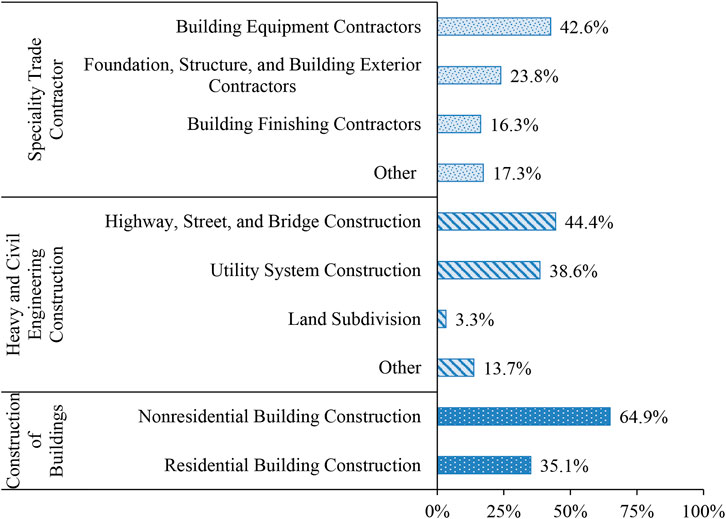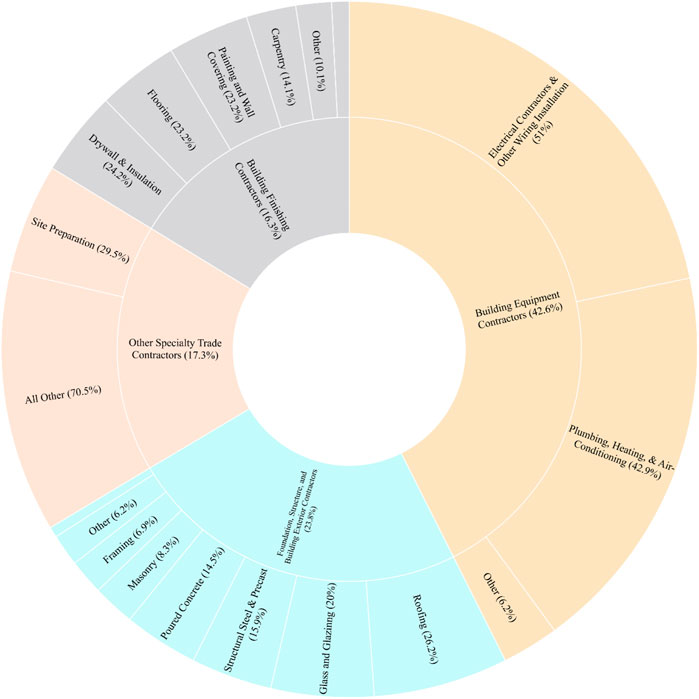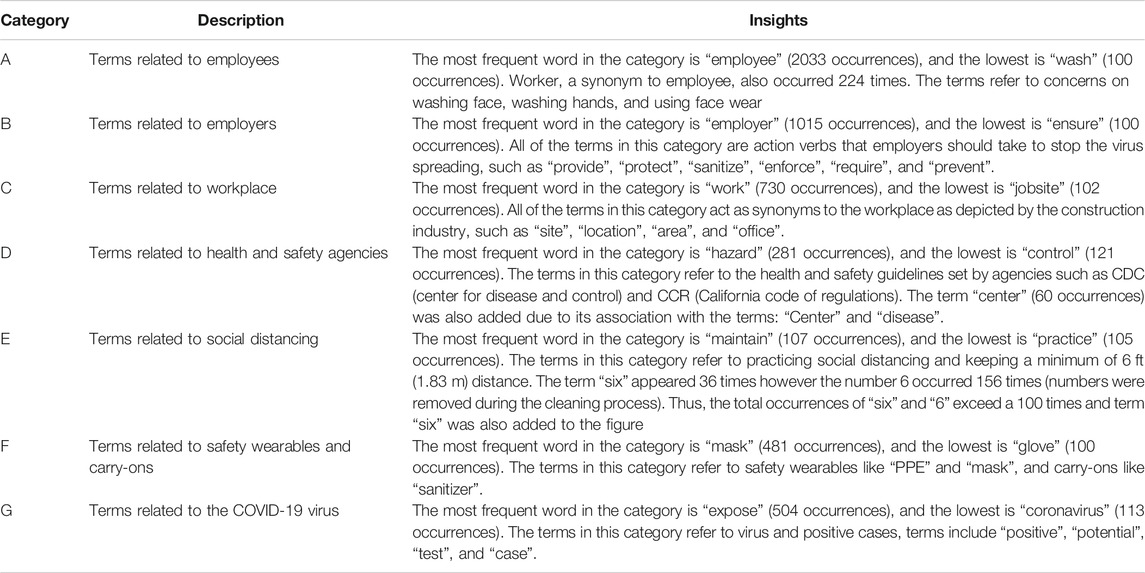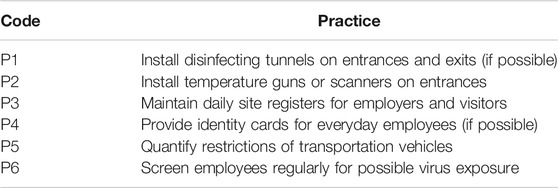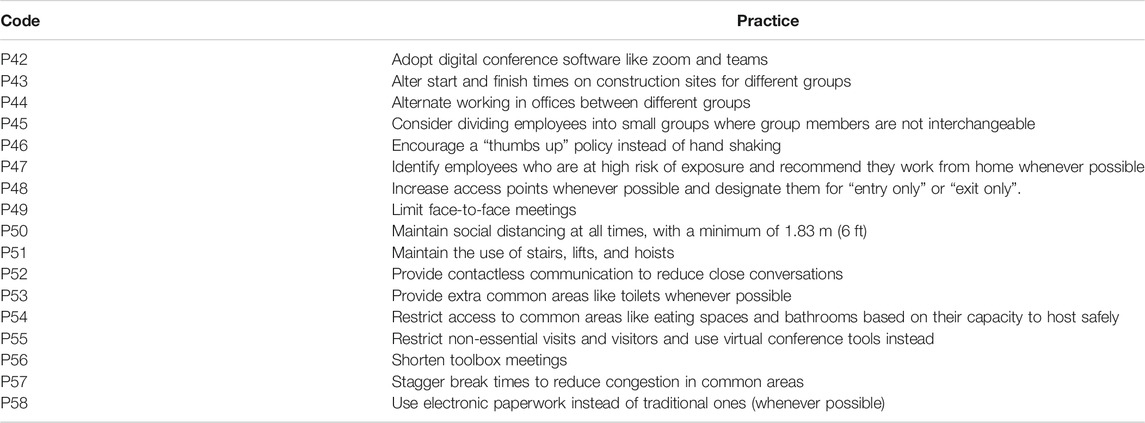- 1Construction Engineering and Project Management Program, Department of Civil Engineering, University of Kentucky, Lexington, KY, United States
- 2Department of Civil and Environmental Engineering, American University of Beirut, Beirut, Lebanon
- 3Department of Civil Engineering, Isfahan (Khorasgan) Branch, Islamic Azad University, Isfahan, Iran
The coronavirus outbreak has created a global health crisis that has disrupted all industries, including the construction industry. Following the onset of the pandemic, construction workers faced and continue to face unprecedented safety and health challenges. Therefore, construction employers established new safety precautions to protect the health and safety of the workforce and minimize the spread of the virus. The new precautions followed the advice and guidelines offered by different health and safety agencies like the Occupational Safety and Health Administration (OSHA), Centers of Disease Control and Prevention (CDC), and the Associated General Contractors of America (AGC). With construction projects resuming operations, it becomes important to analyze the coronavirus-related health and safety concerns of construction workforce and understand how the new safety procedures can assist on jobsites. Existing studies mostly focused on interviews and surveys with construction companies to understand the impact on project performance and supply chains. However, no study has yet to analyze the United States construction workforce. This paper fills the gap by providing a qualitative descriptive analysis of the COVID-19 complaints data gathered by OSHA from construction jobsites. Information gathered by OSHA includes the jobsite location, the North American Industry Classification System (NAICS) of the construction company, the type of the complaint (i.e., formal or non-formal), and a thorough description of the complaint. N-grams were employed to analyze the complaints, detect trends, and compile a list of the most frequent concerns reported by the workforce. The analysis of the complaints data identifies safety practices that were most violated, highlights major safety and health concerns for construction workers, and pinpoints geographical areas that have seen a surge in complaints. The study also synthesized the existing research corpus and compiled a list of 100 best practices that construction employers can adopt to mitigate the concerns of the workforce. The findings of this study provide insights into the safety and health trends on construction sites, lay the foundation for future work of academicians and practitioners to address the concerns faced by construction workers, and serve as lessons learned for the industry in the case of any future pandemic.
Introduction
Coronavirus disease (COVID-19) is a recently discovered disease caused by the novel coronavirus SARS-CoV-2 (World Health Organization, 2021). First detected in December 2019 in Wuhan, China, COVID-19 rapidly spread around the world becoming a global pandemic in March 2020 (World Health Organization, 2020). The virus spreads mostly through droplets released from coughs and exhales, where the droplets may disperse on surrounding surfaces and infect people at a close proximity (Wang L. et al., 2020). The virus can cause severe illnesses to high-risk groups such as those with underlying medical conditions like high blood pressure, heart and lung problems, diabetes, obesity or cancer (Wang D. et al., 2020; World Health Organization, 2020). Nonetheless, any person from any age or medical condition can contract COVID-19 and develop serious illnesses, even death (World Health Organization, 2020). As of March 2021, more than 120 million people around the globe have tested positive for COVID-19 resulting in a death toll that surpassed 2.7 million people (Hopkins, 2021).
To slow the spread of the virus, governments had to implement preventive measures to rapidly respond to the virus such as creating provisions for medical services, designating hospitals for COVID-19, developing isolation areas and testing facilities, and issuing public relief packages and financial assistance (Nawaz et al., 2020a). Governments also had to place restrictions on travels, enforced lockdowns, and limited mobility to essential works (Nawaz et al., 2020a; Jamaludin et al., 2020). The outbreak of the virus and the measures to contain it created worldwide halts to major industries, causing global stock markets to suffer dramatic falls and the global economy to shrink 4.4% in 2020–the worst since the Great Depression of the 1930s (Jones et al., 2021; Szmigiera, 2021). The construction industry is no exception. Known for being sensitive to economic cycles, the construction industry was particularly vulnerable to the drastic decline in economic activity caused by the pandemic (International Labour Organization, 2021).
Prior to the COVID-19 pandemic, there was a pressing need in the construction industry to increase productivity, improve project performance, address labor shortage, reduce fragmentation, introduce standardization, and increase collaboration (Oesterreich and Teuteberg, 2016; Barbosa et al., 2017; Nassereddine et al., 2020a, 2020b; El Jazzar et al., 2020a, 2020b; Bou Hatoum et al., 2020; Hatoum and Nassereddine, 2020; Sawhney et al., 2020). In addition to that, the labor-intensive nature of construction projects and the dynamic nature of construction sites make the construction industry one of most hazardous industries in the world (OSHA, 2019; OSHA, 2020a; Eurostat, 2020; Hatoum et al., 2020). Factors such as unsafe work practices, limited information, risky working condition, lack of technical and material support, negligence in adopting safety rules and laws, and lack of communication worsened the safety and health status on construction sites (Nawaz et al., 2020b). When the pandemic hit, the status of construction projects worsened: more projects suffered from cost and time overruns, material supply chains were disturbed, unemployment increased, the availability of workers decreased, and health and safety became an even bigger concern (International Labour Organization, 2021). Thus, major agencies such as the Center for Disease Control and Prevention (CDC), the Occupational Safety and Health Administration (OSHA), and the Associated General Contractors of America (AGC) released a set of guidelines that construction employers can follow to safely resume work on construction projects as they weather the pandemic storm (OSHA, 2020b; CDC, 2020; AGC, 2021). Moreover, several studies from various parts of the world were published to report on both the status of construction projects and the safety and health precautions that construction companies are implementing on construction projects (Shibani et al., 2020; Alsharef et al., 2021; Ebekozien and Aigbavboa, 2021; Simpeh and Amoah, 2021).
With the topic of health and safety management being at the forefront of the concerns of the construction industry during the COVID-19 pandemic, most of the published studies have focused on analyzing the impact of the pandemic on project performance and developing guidelines to safely execute projects by collecting data through interviews or surveys with selected subject matter experts (Jamaludin et al., 2020; Majumder and Biswas, 2021; Simpeh and Amoah, 2021). While construction workers are the heartbeat of every construction project, there has been limited discussion on the perception of workers in the pandemic and the effectiveness of the newly established safety measures. One tool that has been available to workers in the United States of America (USA) to report on their safety concerns is the OSHA Complaint tracker. OSHA is a large regulatory agency of the United States Department of Labor with a main mission to inspect and examine the health and safety in workplaces in various industries, including the construction industry (OSHA, 2020c). Construction workers had access to the OSHA Complaint tracker during the pandemic, and complaints made by construction workers nationwide were compiled into a database that is published on the OSHA website. The investigation of this database can provide great insights into the perception of the construction workers of how well the construction projects were managed during the pandemic. Therefore, this paper provides a qualitative descriptive analysis of the COVID-19 construction-related complaints published by OSHA to better understand the nature of concerns of the USA workforce. Moreover, using the existing research corpus and the guidelines released by official agencies, the study outlines a list of 100 recommendations to tackle the concerns highlighted by the workers to enable the construction industry to safely navigate through the pandemic.
Literature Review
Numerous studies were performed to investigate the impact of the pandemic on the construction industry. Hansen (2020) described COVID-19 in the context of the construction industry as an unforeseeable, unavoidable, uncontrollable, and impractical event that is beyond the reasonability of any party. According to the author, the event was unforeseeable as it started from Wuhan and spread across the globe at an unprecedented scale, unavoidable because all industries were affected including the labor-intensive construction industry, uncontrollable since its impact is beyond the control of contracting parties, impracticable because its direct and indirect impacts on the construction industry affects the fulfillment of contractual obligations, and beyond the responsibility of any party given that it is a global health crisis and declared by many countries as a national disaster (Hansen, 2020). The author suggested that the contractor and employer should establish a COVID-19 prevention task force capable to educate workers on the virus, coordinate with the hospitals, identify potential risks and virus spreads, and control the health and safety on the construction site (Hansen, 2020).
Impacts of the COVID-19 Pandemic on the Construction Industry Worldwide
Gamil and Alhagar (2020) collected input from a survey conducted on 129 respondents and a series of structured interviews with 10 experts to understand the impact of COVID-19 on construction. According to respondents, the most severe impacts of the pandemic are: (1) suspension of projects due to constraint movements and supply shortage, (2) workforce shortage due to suspension of projects and the spreading of the virus in gatherings, (3) time overrun which is associated with the movement and measure control period, and (4) cost overrun and financial impact caused by the economic deterioration, project suspension, and ongoing overhead costs to keep companies running (Gamil and Alhagar, 2020). Other impacts include supply shortage, material price fluctuations, legal issues and interruptions in contractual terms, impact on existing accomplished activities, uncertainty of survival, and impact on research and technology (Gamil and Alhagar, 2020). Moreover, Ogunnusi et al. (2020) identified common positive and negative experiences with COVID-19 through a questionnaire conducted with 71 construction industry professionals from different regions around the world (54.9% of respondents from Africa, 2.5% from Asia, 18.3% from Europe). When asked about positive impacts, respondents agreed that “the opportunity to improve on virtual alternatives” has been empowered by the pandemic where digital platforms have enabled the continuity of meetings previously held as face-to-face only (Ogunnusi et al., 2020). Other positive impacts include deploying and enhancing the use of technology, improving material planning and workplace design, encouraging collaboration and risk assessment, emphasizing on Personal Protective Equipment (PPE), and increasing off-site works (Ogunnusi et al., 2020). As for negative impacts experienced by the respondents, the pandemic has worsened ongoing project problems such as cost and schedule overruns, mainly due to the daily hardships faced by labor and the ineffective work from home for site-based processes (Ogunnusi et al., 2020).
Impact of the COVID-19 Pandemic on Regional Construction Industries
While researchers have been mostly discussing the impact of the pandemic on the construction industry worldwide, some studies were more specific to certain regions. Examples of these studies are shown in Table 1.

TABLE 1. Selected studies on the impact of the COVID-19 pandemic on regional construction industries.
Impact of the COVID-19 Pandemic on the United States Construction Industry
In the USA, Alsharef et al. (2021) conducted a series of structured interviews with 34 construction professionals on the impacts of the pandemic on their work. General and adverse impacts of the pandemic included: (1) disparities across states on whether construction operations are essential or non-essential, (2) material delivery delays and shortage of material, (3) increase in demands from local suppliers and manufacturers, (4) delays in inspections and securing permits, (5) reduction in efficiency and production rate, (6) suspension or slowing of ongoing projects and delay in the start of new projects, (7) price escalations, additional costs, loss of revenue, payment delays, (8) safety concerns regarding virus spread in workplaces, (9) transition to work from home for non-site personnel, and (10) expected increase in disputes, litigation, and claims (Alsharef et al., 2021). Moreover, the authors brought awareness to the efforts needed to mitigate the challenges through developing new safety measures to keep construction sites safe, and managing various project risks such as time delays, costs overruns, and material shortage. The study also discussed new opportunities that may arise due to the pandemic, including the ability to secure loans at low-interest rates, recruitment of skilled workers post-pandemic, and increase in demand for certain types of projects such as transportation, infrastructure, warehouses, residential, fast-track medical, and public facilities (Alsharef et al., 2021). Other major opportunities include the internal reviews that companies will undergo to improve existing systems such as rethinking current processes, utilizing technology, reducing operational and overhead costs, and enhancing equipment and tools (Alsharef et al., 2021).
Studies Related to the Health and Safety Concerns of the Construction Workforce
In addition to the above studies, some researchers tackled the safety and health concerns of the construction workforce. (Pamidimukkala et al., 2021) highlighted major safety and health concerns that the construction workforce may face in the COVID-19 pandemic. According to the study, concerns include (1) concerns about the risk of being exposed to the virus at work, (2) thinking of personal and family while working, (3) managing different workloads, (4) isolation, (5) lack of access to tools and equipment needed to perform the job, (6) feeling of not contributing enough for work, (7) uncertainty about the future of the workforce, (8) adapting to different workplaces and new schedules, and (9) learning new communication tools and dealing with technical difficulties. The study suggested that implementing some measures can mitigate the effect of the concerns. Such measures include redefining jobsite safety, increasing technology use, prolonging project timelines, increasing remote work, adding flexibility to work schedules, providing extra training, enhancing communication, and teaching to recognize stress symptoms (Pamidimukkala et al., 2021). Zheng et al. (2021) investigated the knowledge, attitudes, and practices (KAP) of construction industry practitioners in China. Results revealed that a significant minority of practitioners did not have enough information about the spread of the virus, a significant majority was optimistic about winning the battle against COVID-19, and more safety measures should be enforced (Zheng et al., 2021). In another study, Denny-Smith et al. (2021) provided recommendations on how construction employers can create social value and assist recovery from the COVID-19 crises. The study recommends that future construction investments that create new jobs and/or reopen lost ones after the COVID-19 lockdowns should provide both culture and work benefits. For example, besides adequate pays and incomes, companies should be more inclusive and diverse, engage more with their communities, embrace cultures, and provide employees with a better work-life balance, good mental health management practices, more opportunities to grow, and enhanced guidance and communication from management. Such benefits can create much-needed social value to employees who are rebuilding their life after the COVID-19 pandemic (Denny-Smith et al., 2021).
Methodology
The main objective of this paper is to investigate the perceptions of construction workers in USA on how well health and safety measures were imposed on construction projects during the pandemic. This overarching objective is achieved through two intermediate objectives: (1) analyze the construction-related complaints submitted to the OSHA Complaint tracker, and (2) outline a list of recommendations to tackle the concerns.
To achieve the first intermediate objective, the COVID-19 complaints database was first downloaded from the OSHA website. The data was sorted by the North American Industry Classification System (NAICS) index to only extract the construction-related complaints. As a result, the database for closed COVID-19 safety and health compliance data included a total 1,403 complaints associated with the construction industry (around 3.3% of the total dataset). All the complaints were recorded between March 1st, 2020 and January 18th, 2021. Each complaint included information on the company for which the worker works, such as company name, address, and the North American Industry Classification System (NAICS) index. Additional information included the means by which the complaint was received, the type of the complaint, and a description of the hazards for each complaint. The names and addresses of the companies were excluded from the study and only the state where the complaint was filed is reported. Then, the text mining technique N-gram was employed to analyze the complaints, detect trends, and compile a list of the concerns that were most frequently reported by the workforce.
To achieve the second intermediate objective, the authors reviewed numerous studies that surveyed or interviewed construction employers and examined the latest guidelines released by OSHA, CDC, and AGC to compile a set of recommendations to address the concerns identified in the first objective. A list of 100 best practices that were grouped by common themes was identified.
Analysis of Complaints
The OSHA online database for closed COVID-19 safety and health compliance data included a total 1,382 complaints associated with the construction industry and recorded between March 1st, 2020 and January 18th, 2021. The names and addresses of the companies were excluded from the study and only the state in which the complaint was filed was reported to enable geographical analysis. The following sections describe the various features and variables included in the OSHA database. Analysis was performed using RStudio, and graphs were generated using RStudio and Microsoft Excel (Microsoft Corporation, 2021; RStudio Team, 2021).
Distribution of Complaints by State
To gain insights into what states were experiencing more health and safety violations, the 1,382 complaints were mapped according to the geographic location as illustrated in Figure 1. The map shows that most complaints were filed in California (18.7%), followed by Oregon (17.2%), Indiana (8.8%), Nevada (7.1%), then Michigan (5.4%). New Hampshire was the only state with no construction-related complaints, and so was Washington D.C.
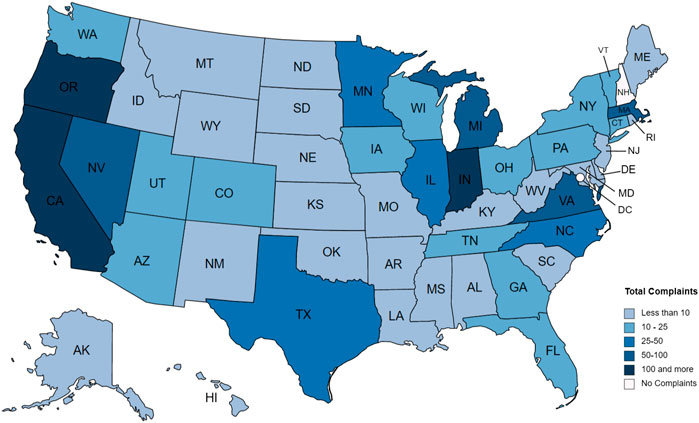
FIGURE 1. Distribution of construction-related complaints across the states–generated by mapchart.net.
Distribution of Complaints by Time
The total number of construction-related complaints recorded each month for the period between March 2020 and mid-January 2021 is plotted in Figure 2. According to the results, the highest number of construction-related complaints closed by OSHA in 2020 was in April (284), and the lowest was in September (62). As far as 2021, the number of complaints recorded as of January 18th, 2021 was (30), less than half of what was recorded in September 2020.
When comparing the trend of construction-related complaints to the trend of COVID-19 cases in the USA, it can be noted that the construction-related complaints were higher in the early stages of the pandemic. However, complaints from the construction workforce gradually decreased despite the continuous increase in confirmed positive COVID-19 cases. This increase in construction-related complaints amid the active spread of COVID-19 can be attributed to the scarcity of information about the virus in USA and the little guidance provided from safety and health agencies. As a result, construction companies needed time to understand the spread of the virus and its impacts on their operations in order to develop a plan to mitigate these impacts. After enforcing major lockdowns across the USA in Spring of 2020 and as more health and safety guidelines were being published, construction-complaints started to gradually decrease, indicating that the construction industry was becoming better at controlling the spread of the disease and adopting the appropriate safety measures.
It should also be noted that the change in the number of construction-related complaints was directly proportional to the total number of closed complaints recorded from all industries every month (Figure 3), where construction-related complaints collected between March 2020 and January 2021 averaged 3.3% of all COVID-19 complaints. The highest percentage of construction-related complaints were recorded in March and April where construction tallied 4.7 and 4.5% of all complaints. The lowest percentage of construction-related complaints was observed in July and August with 2.4 and 2.3% respectively.
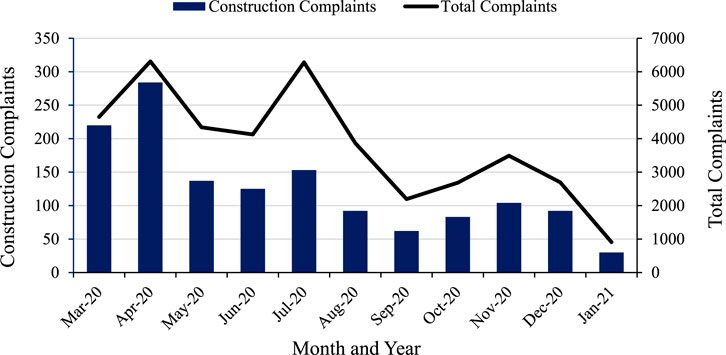
FIGURE 3. Variation of construction-related complaints as compared to the total complaints with time.
Distribution of Complaints by Receipt
Regarding the types of receipts used by workers to communicate construction-related complaints, more than half of the employees used the phone (54.5%) as seen in Figure 4, 21.56% submitted their complaints online, and 20.69% via email. The other receipts included complaints filed using a hotline (1.5%), mailed (1.1%), faxed (0.5%), and submitted in-person (0.2%). The only type of receipts that was not used for reporting construction-related complaints was the media.
Distribution of Complaints by NAICS
Based on the NAICS distribution of the data, 45% of the complaints were related to the Construction of Buildings, 44% to Specialty Trade Contractors, and 11% to Heavy and Civil Engineering Construction. The distribution of the complaints for each category is shown in Figure 5.
For the Construction of Buildings category, residential construction complaints varied between new single-family housing construction (39%), new multifamily housing construction (23.4%), new housing for-sale builders (6.9%), and residential remodelers (3.7%). On the other hand, non-residential construction complaints varied between industrial (13.9%) and commercial and institutional (86.1%) building construction.
For the Heavy and Civil Engineering Construction category, complaints in the utility system construction varied between the construction of water and sewer line and related structures (42.4%), power and communication lines and related structures (42.4%), and oil and gas pipeline and related structures (15.2%).
For the Specialty Trade Contractors category, the distribution of the sub-categories (and the sub-sub- categories) is displayed in Figure 6. Overall, the specialty trade contractors that had the most complaints were electrical contractors and other wiring installations (9.6% of total construction-related complaints), followed by plumbing, heating, air conditioning contractors (8% of total construction-related complaints), roofing contractors (2.8% of total construction-related complaints), and site preparation contractors (2.2% of total construction-related complaints).
Formality of Complaints
An important factor to consider when analyzing construction-related complaints is the type of the complaint. According to OSHA, complaints can be either formal or non-formal. A formal complaint is defined by OSHA as a “complaint made by a current employee or a representative of employees that meets three requirements: (1) asserts that an imminent danger, a violation of the Act, or violation of an OSHA standards exposing employees to physical harm exists in the workplace; (2) reduced to writing or submitted on an OSHA-7 form; and (3) signed by at least one current employee or employee representative” (OSHA, 2020c). A non-formal complainant is “any complaint alleging safety or health violations that does not meet all of the requirements of a formal complaint identified above” (OSHA, 2020c). According to the data, 26% of the construction-related complaints were formal and the remaining 74% were non-formal. When compared to the entire dataset of all COVID-19 complaints, construction-related complaints accounted for 2.8% of all formal complaints, and 3.6% of all non-formal complaints.
Reasons for Complaints
For each complaint reported by construction workers, a description was provided to elaborate on the concerns. To gain insights into the major concerns of construction workers, the descriptions were analyzed to identify the most frequently used words that could highlight health and safety concerns for the construction workforce. Figure 7 summarizes the most frequent terms identified in the construction-related complaints submitted by the construction workers. The figure was generated using RStudio (RStudio Team, 2021). Prior to creating this figure, the raw description of the 1,382 complains was pre-processed and cleaned by removing punctuation, changing words to lowercase letters, deleting numbers, and removing extra white spaces. Then, since the data was captured in English, English stop words, i.e., words that can be removed without affecting the meaning of the sentence, were removed from the descriptions. For instance: “and”, “but”, “the”, “because”, “he”, “she”, and the likes were all deleted from the raw descriptions. The data was also stemmed to reduce words to their base or root forms, and then counted. Stemmed words that were used at least 100 times were reviewed, and then grouped in terms of similarities and associations.
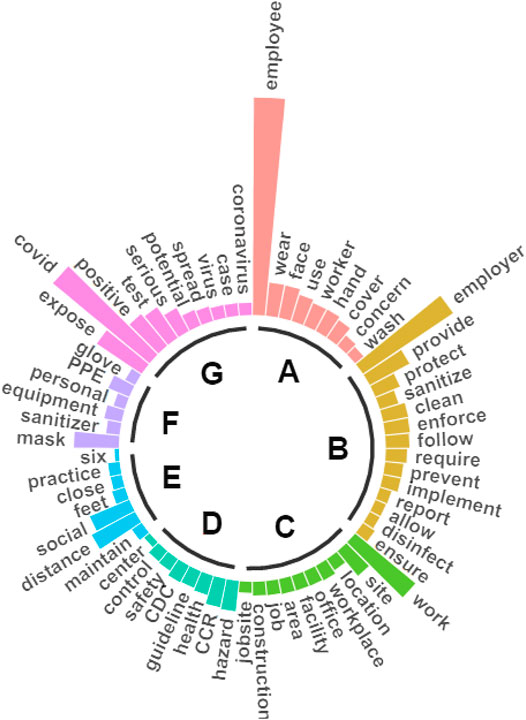
FIGURE 7. Most frequent terms used in the complaints' description section and their categories–Figure generated with the R code provided by (Holtz, 2018).
Applying frequency analysis to the cleaned dataset resulted in seven categories as illustrated in Figure 7 and discussed in Table 2: terms related to employees (Category A), terms related to employers (Category B), terms related to place of work (Category C), terms related to health and safety agencies (Category D), terms related to social distancing (Category E), terms related to safety wearables and carry-ons (Category F), and the terms related to the COVID-19 virus (Category G).
During this process, stemmed words were also reviewed in their original form to make sure of their intended use. For example, “employees” and “employers” shared common stems, so the frequency of their original forms was considered. Another example is “sanitized” and “sanitizer”; while “sanitizers” had associations with hand and soap, “sanitized” was associated with materials, objects, and rooms on construction sites.
To extract valuable insights from the provided descriptions, the N-gram text mining technique was employed to analyze the concerns submitted by the construction workforce and find common themes. N-gram can be simply defined as a sequence of “N” words (Jurafsky and Martin, 2020). For example, breaking “employer did not enforce masks” into 2-g will result in “employer did”, “did not”. “not enforce”, and “enforce masks”. Breaking the same sentence into 3-g will result in “employer did not”, “did not enforce”, “not enforce masks”. 2-g are normally referred to as bigrams, while 3-g are referred to as trigrams (Kumar, 2017).
In this study, the code was run to compile frequent bigrams, trigrams, 4-g, 5-g, 6-g, 7-g, 8-g, and 9-g. After examining and analyzing the generated lists, the following nine concerns were derived:
• Personnel who tested positive continued to report to work
• Personnel who were exposed to the virus continued to report to work
• Employers did not enforce social distancing
• Employers did not provide masks and PPE such as gloves and face shields
• Employers did not provide hand-wash facilities and hand-wash sanitizers
• Employers did not take precautions to protect employees from contracting the virus as set by the safety and health agencies, or state local policies
• Employers did not disinfect or deep clean the workplace
• Employees were not wearing face covers despite the mask mandates
Best Practices and Recommendations
The above section highlighted the health and safety concerns that construction labor developed during the COVID-19 pandemic. To mitigate these concerns, construction companies implemented a set of guidelines as recommended by health and safety agencies such as OSHA, CDC, and AGC. Other companies went beyond the guidelines and established their own stringent regulations to better control the spread of the virus and protect their employees. These guidelines, if followed, can be extremely important to resolve the health and safety concerns raised by the construction workforce through their complaints to OSHA. As new information about the virus and its spread comes to light, OSHA, CDC, and AGC are continuously updating their guidelines. While all published guidelines aim to provide a healthy and safe workplace for construction workers, the practices identified by the three health and safe agencies are complementary. Therefore, this section summarizes the different best practices of OSHA (OSHA, 2021), CDC (CDC, 2021), and AGC (AGC, 2020) and recommendations outlined by Han et al. (2020), Jamaludin et al. (2020), Lovcheva (2020), Mitchell (2020), Assaad and El-adaway (2021), Majumder and Biswas (2021), and Simpeh and Amoah (2021). The best practices are clustered into 11 themes: access points, communication and awareness, compliance, daily tasks and activities, engineering controls, exposure response plan, human interactions, hygiene and sanitization, management of deliveries, physical and mental health, and safety wearables and carry-ons. It is important to note that all the best practices mentioned were comprehensively compiled from the listed references. Moreover, the 11 themes and their corresponding practices are not listed in an ascending or descending order, but rather they are listed in alphabetical order.
Access Points
The objective of this theme is to control access points to the workplace, which can be achieved through the various practices shown in Table 3. For instance, simple measures such as taking the temperatures of employees could show whether any person is sick and send them back home (P2). Screening can also be extremely important to identify possible exposures (P6). Screening questions can include whether the employee or any of their family members were in contact with an infected person, whether they were in contact with a person in the process of being tested for infection, whether they traveled outside the USA, whether they have been medically directed to self-quarantine, or whether they have been having trouble breathing or flu-like symptoms in the last 48 h. Moreover, maintaining site registers can assist in tracing possible exposures (P3).
Communication and Awareness
The objective of this theme is to enhance communication within the company and provide awareness on the virus. A total of 11 practices were identified under this theme, as shown in Table 4. For example, construction employers should promote COVID-19 awareness between employees, including methods of spreading, protection, and prevention from the virus (P7, P14, P15). Employees should also be familiar with all possible symptoms including fever, cough, shortness of breath, sore throat, chills, runny or stuffy nose, fatigue, or body aches (P16). Moreover, employers should keep employees updated on COVID-19 news and the plan for the vaccination, especially with the high amount of misinformation spreading about the virus (P12, P13). Employers can communicate with their employees through numerous means such as brief meetings, webinars, posters, signages, emails, social media groups, and regular toolbox meetings.
Compliance
The objective of this theme is to ensure safety and health compliance in the workplace. This overarching theme can be achieved through the different practices shown in Table 5. For example, safety and health officers or safety site supervisors should be responsible to ensure that the workers adhere to the safety regulations to prevent possible exposures to the virus (P22, P23). Procedures to reward compliance and discipline non-compliance can be helpful (P18, P19). Moreover, getting the vaccine does not grant any employee the freedom to stop being cautious, as the risk of exposure and spreading the virus remains (P20).
Daily Tasks and Activities
This theme focuses on assessing daily tasks and activities to identify risks of virus exposure and eliminate or limit them as much as possible. As shown in Table 6, seven practices are identified for this theme. OSHA divided construction work tasks into three exposure risk levels: low, medium, and high (OSHA, 2021). Tasks with a low-level exposure risk are “tasks that allow employees to remain at least 1.83 m (6 ft) apart with little contact with public, visitors, or customers”. Tasks with a medium-level exposure risk are “tasks that require workers to be within 1.83 m (6 ft) of one another” or “tasks that require workers to be in close contact (within 1.83 m or 6 ft) with customers, visitors, or members of the public”. Tasks with a high-level exposure risk happen when employees “enter an indoor work site occupied by people such as other workers, customers, or residents suspected of having or known to have COVID-19, including when an occupant of the site reports signs and symptoms consistent with COVID-19”. OSHA’s classification can be very helpful in identifying what tasks need immediate attention (i.e., middle risk) and what tasks should be delayed (i.e. high risk).
Engineering Controls
The objective of this theme is to implement engineering controls in the workplace. Five practices are identified under this theme and are shown in Table 7. Major examples of engineering controls include physical barriers (P33), ventilation (P30, P31), and humidity (P34).
Exposure Response Plan
The objective of this theme is to create and implement a response plan in case of a possible virus exposure or if an employee develops symptoms during work hours. Practices supporting this theme are listed in Table 8. As the virus may be unpredictable, employers must put a response plan in case an employee is suspected to have been infected with COVID-19. The plan should include measures to isolate the employee (P38), safely transport the outside the workplace (P36) and sanitize (P39). Moreover, adopting an effective record-keeping system can be very helpful in tracing down employees who may have been exposed to the virus (P35, P40).
Human Interactions
The objective of this theme is to minimize human interactions as much as possible, which can be enabled through the various practices shown in Table 9. Important practices in this category include altering shifts whether in sites or offices (P43, P44), altering breaks (P57), encouraging online meetings instead of in-person ones (P42, P49), and providing contactless communication like walkie talkies (P52). One important aspect to consider as well is to divide employees into small groups that are not interchangeable (P45). Group members in every team can be cross-trained to perform essential functions and provided with required alternative sources to facilitate works that require specific skills. Such a practice can be vital to limit virus exposure and decrease the risk of an outbreak. Moreover, dividing entrances between entrance and exits can minimize interactions, and adding more entrances can reduce congestion on screening and temperature checks (P48).
Hygiene and Sanitization
This theme emphasizes the need to maintain hygiene in the workplace, which can be achieved through the different practices shown in Table 10. For example, common contact surfaces such as tables, chairs, doorknobs, handrails, lift buttons, hoist buttons, handrails, ladders, and hand tools must be sanitized regularly (P70, P71). Hand washing facilities must be installed at convenient locations for all workers to access regularly and safely, while being provided with extra supplies of soap, hand sanitizer and paper towels (P65). Disinfection and sanitization procedures should be also applied to common vehicle surfaces such as gear shifts, steering wheels, and instrument panels.
Management of Deliveries
This theme aims to manage and handle deliveries safely and avoid possible virus exposure and includes a set of practices as outlined in Table 11. Under this theme, employers should develop special systems to handle material and equipment delivery, especially since the virus can stay on surfaces for days. Plans should include coordinating with suppliers for touch free deliveries and keeping drivers in their vehicles (P76), dedicating special areas with limited access to a number of employees (P75, P77), and sanitizing materials and equipment (P78). Another important aspect is that any paper used in the delivery process–especially if electronic signatures and receipts are not an option–should be placed in quarantine boxes before sending to the correct personnel because the virus may be on the papers and can thus spread (P79).
Physical and Mental Health
The objective of this theme is to care for the physical and mental health of the employees. Employers need to understand that a pandemic can add work and home related stress due to different factors. CDC lists the following as potential sources of added pressure on the employees: “concerns about being exposed to the virus at work”, “lack of access to the tools and equipment needed to perform the job”, “conflicts at home”, “failure to take time to relax”, “feelings that you are not contributing enough to work”, “feeling guilty about not being on the frontline”, “uncertainty about the future of your workplace and/or employment”, and “adapting to a different workspace and/or work schedule” (CDC, 2021). Additionally, other factors like finances and worrying about vulnerable family members can aggravate the situation. Thus, the practices shown in Table 12 play a major role in caring for the physical and mental health of the employee.
Safety Wearables and Carry-Ons
The objective of this theme is to provide and manage safety wearables and carry-ons to protect and shield employees from the virus. This theme is illustrated through the various practices shown in Table 13. Examples of wearables include masks and PPE like gloves, boots, eye protection, face shields (P93, P95). Examples of carry-ons include sanitizers, wipes, and hand soaps (P94, P96).
Conclusions, Limitations, and Further Studies
As researchers have been investigating the impacts posed by the global health threat COVID-19 on the construction industry and the guidelines developed to help fight the outbreak, there has been limited discussions on the concerns of construction workers–a group whose daily lives have been impacted. Using construction workers complaints collected through the OSHA Complaint tracker tool between March 1st, 2020 and January 18th, 2021, this study analyzed the reported complaints and outlined 100 health and safety practices to tackle the concerns of the construction workforce.
The analysis of the OSHA database showed that construction-related complaints were mainly reported in the states of California, Oregon, and Indiana. Complaints peaked in March and April of 2020 then decreased gradually. Almost half of the complaints were related to the Construction of Buildings category of work–specifically nonresidential building construction. The other half was related to Specialty Trade Contractors, notably building equipment contractors such as Mechanical, Electrical, and Plumbing (MEP) subcontractors. Half of the construction-related complaints were filed using the phone, and the majority of the complaints were deemed non-formal. Regarding the nature of the complaints, most construction workers voiced concerns over personnel who tested positive to the virus or were exposed to COVID-19 and kept reporting to work; employees were not abiding by mask mandates; and employees were not taking precautions, enforcing social distancing, and providing masks and PPE.
To mitigate the concerns, the author then reviewed the existing research corpus and the guidelines set by three major safety and health agencies–namely OSHA, CDC, and AGC–and compiled a list of 100 best practices. The practices were divided into 11 themes: access points, communication and awareness, compliance, daily tasks and activities, engineering controls, exposure response plan, human interactions, hygiene and sanitization, management of deliveries, physical and mental health, and safety wearables and carry-ons. It should be noted, however, that while the reviewed guidelines outline recommendations for best practices, as new information about the virus and its spread comes to light, OSHA, CDC, and AGC are continuously updating their guidelines to account for the changing environment.
The study does come with some limitations. The nature of the analysis performed in this paper was qualitative descriptive, therefore, future work can employ statistical techniques to test hypotheses and correlate the health and safety concerns of construction workers to the performance of construction projects. Additionally, the analysis was performed for the period between March 1st, 2020 and January 18th, 2021 and therefore, the results do not provide insights into how the COVID-19 situation is unfolding among the construction workers as the vaccines are being rolled out. Moreover, while 100 health and safety practices were synthesized, the author recognize that not all 100 practices are equally effective. Therefore, future study can assess the effectiveness of these practices as well as other practices that may be implemented depending on how the COVID-19 pandemic evolves on the jobsite.
Data Availability Statement
Publicly available datasets were analyzed in this study. This data can be found here: https://www.osha.gov/foia/archived-covid-19-data.
Author Contributions
MB: conceptualization, resources, methodology, formal analysis, discussion, visualization, writing - original draft preparation and visualization. AF: resources, formal analysis, discussion, writing - original draft preparation. HN and HS: writing - reviewing, editing, and administering the paper. All authors have read and agreed to the published version of the manuscript.
Conflict of Interest
The authors declare that the research was conducted in the absence of any commercial or financial relationships that could be construed as a potential conflict of interest.
References
AGC (2020). COVID-19 Recommended Practices for Construction Jobsites. Available at: https://www.agc.org/sites/default/files/Files/Safety%20%26%20Health/COVID19%20Recommended%20Practices%20031920.pdf.
AGC (2021). Coronavirus (COVID-19). Available at: https://www.agc.org/coronavirus (Accessed March 23, 2021).
Alenezi, T. A. N. (2020). The Impact of Covid-19 on Construction Projects in Kuwait. Int. J. Eng. Res. Gen. Sci. 8, 6–9.
Alsharef, A., Banerjee, S., Uddin, S. M. J., Albert, A., and Jaselskis, E. (2021). Early Impacts of the COVID-19 Pandemic on the United States Construction Industry. Int. J. Environ. Res. Public Health 18, 1559. doi:10.3390/ijerph18041559
Assaad, R., and El-adaway, I. H. (2021). Guidelines for Responding to COVID-19 Pandemic: Best Practices, Impacts, and Future Research Directions. J. Manage. Eng. 37 (3), 06021001. doi:10.1061/(asce)me.1943-5479.0000906
Barbosa, F., Woetzel, J., Mischke, J., Ribeirinho, M. J., Sridhar, M., Parsons, M., et al. (2017). Reinvinting Construction: A Route to Higher Productivity. McKinsey Global Institute Available at: https://www.mckinsey.com/mgi/overview.
Bou Hatoum, M., Piskernik, M., and Nassereddine, H. (2020). “A Holistic Framework for the Implementation of Big Data throughout a Construction Project Lifecycle,” in 2020 Proceedings of the 37th International Symposium on Automation and Robotics in Construction (ISARC 2020), (Kitakyushu, Japan: International Symposium on Automation and Robotics in Construction), 1299–1306. doi:10.22260/ISARC2020/0178
CDC (2020). Resuming Business Toolkit. Available at: https://www.cdc.gov/coronavirus/2019-ncov/community/resuming-business-toolkit.html (Accessed March 23, 2021).
CDC (2021). Construction COVID-19 Safety Checklist for Employees. Available at: https://www.cdc.gov/coronavirus/2019-ncov/downloads/community/organizations/Construction-COVID-19-Checklist-for-Employees.pdf (Accessed March 23, 2021).
Denny-Smith, G., Sunindijo, R. Y., Loosemore, M., Williams, M., and Piggott, L. (2021). How Construction Employment Can Create Social Value and Assist Recovery from COVID-19. Sustainability 13 (2), 988. doi:10.3390/su13020988
Ebekozien, A., and Aigbavboa, C. (2021). COVID-19 Recovery for the Nigerian Construction Sites: The Role of the Fourth Industrial Revolution Technologies. Sustain. Cities Soc. 69, 102803. doi:10.1016/j.scs.2021.102803
El Jazzar, M., Piskernik, M., and Nassereddine, H. (2020a). “Digital Twin in Construction: An Empirical Analysis,” in EG-ICE 2020 Workshop on Intelligent Computing in Engineering. Editors L. C. Ungureanu, and T. Hartmann (Berlin, Germany: TU Berlin), 501–510.
El Jazzar, M., Urban, H., Schranz, C., and Nassereddine, H. (2020b). “Construction 4.0: A Roadmap to Shaping the Future of Construction,” in 2020 Proceedings of the 37th International Symposium on Automation and Robotics in Construction (ISARC 2020), (Kitakyshu, Japan: International Symposium on Automation and Robotics in Construction), 1314–1321. doi:10.22260/ISARC2020/0180
Esa, M. B., Ibrahim, F. S. B., and Kamal, E. B. M. (2020). Covid-19 Pandemic Lockdown: The Consequences towards Project Success in Malaysian Construction Industry. Adv. Sci. Technol. Eng. Syst. J. 5 (5), 973–983. doi:10.25046/aj0505119
Eurostat (2020). Accidents at Work Statistics. Available at: https://ec.europa.eu/eurostat/statistics-explained/index.php?title=Accidents_at_work_statistics#Number_of_accidents (Accessed March 23, 2021).
Gamil, Y., and Alhagar, A. (2020). The Impact of Pandemic Crisis on the Survival of Construction Industry: A Case of COVID-19. Mediterr. J. Soc. Sci. 11 (4), 122–128. doi:10.36941/mjss-2020-0047
Han, E., Tan, M. M. J., Turk, E., Sridhar, D., Leung, G. M., Shibuya, K., et al. (2020). Lessons Learnt from Easing COVID-19 Restrictions: an Analysis of Countries and Regions in Asia Pacific and Europe. Lancet 396 (10261), 1525–1534. doi:10.1016/S0140-6736(20)32007-9
Hansen, S. (2020). Does the COVID-19 Outbreak Constitute a Force Majeure Event? A Pandemic Impact on Construction Contracts. J. Civil Eng. Forum 6 (2), 201–214. doi:10.22146/jcef.54997
Hatoum, M. B., Hamzeh, F., and Khoury, H. (2020). “Perspectives of Contractors and Insurance Companies on Construction Safety Practices: Case of a Middle Eastern Developing Country,” in Construction Research Congress 2020 (Tempe, Arizona: American Society of Civil Engineers), 366–374. doi:10.1061/9780784482872.040
Hatoum, M. B., and Nassereddine, H. (2020). “Developing a Framework for the Implementation of Robotics in Construction Enterprises,” in EG-ICE 2020 Workshop on Intelligent Computing in Engineering. Editors L. C. Ungureanu, and T. Hartmann (Berlin, Germany: TU Berlin), 453–462.
Holtz, Y. (2018). Circular Barplot with Groups. The R Graph Gallery. Available at: https://www.r-graph-gallery.com/297-circular-barplot-with-groups.html (Accessed March 23, 2021).
Hopkins, J. (2021). COVID-19 Dashboard by the Center for Systems Science and Engineering (CSSE) at Johns Hopkins University (JHU). Available at: https://coronavirus.jhu.edu/map.html (Accessed March 23, 2021).
`International Labour Organization (2021). Impact of COVID-19 on the Construction Sector. Geneva, Switzerland: International Labour Organization Available at: https://www.ilo.org/sector/Resources/publications/WCMS_767303/lang--en/index.htm (Accessed March 23, 2021).
Jamaludin, S., Azmir, N. A., Mohamad Ayob, A. F., and Zainal, N. (2020). COVID-19 Exit Strategy: Transitioning towards a New Normal. Ann. Med. Surg. 59, 165–170. doi:10.1016/j.amsu.2020.09.046
Jones, L., Palumbo, D., and Brown, D. (2021). Coronavirus: How the Pandemic Has Changed the World Economy. BBC News Available at: https://www.bbc.com/news/business-51706225 (Accessed March 23, 2021).
Jurafsky, D., and Martin, J. H. (2020). “Chapter 4: Naive Bayes and Sentiment Classification,” in Speech and Language Processing: An Introduction to Natural Language Processing, Computational Linguistics, and Speech Recognition. Stanford University and University of Colorado at Boulder.
King, S. S., Rahman, R. A., Fauzi, M. A., and Haron, A. T. (2021). Mechanisms for Addressing the Impact of COVID-19 on Infrastructure Projects. IOP Conf. Ser. Earth Environ. Sci. 682, 012047. doi:10.1088/1755-1315/682/1/012047
Kumar, P. (2017). An Introduction to N-Grams: What Are They and Why Do We Need Them? XRDS Crossroads. Available at: https://blog.xrds.acm.org/2017/10/introduction-n-grams-need/. (Accessed March 23, 2021)
Lovcheva, M. V. (2020). “Organization of Labor Activity at Construction Enterprise During the Spread of Coronavirus,,” in Digital Economy and the New Labor Market: Jobs, Competences and Innovative HR Technologies Editors S. I. Ashmarina, and V. V. Mantulenko (Cham: Springer), 210–220. doi:10.1007/978-3-030-60926-9_28
Majumder, S., and Biswas, D. (2021). “COVID-19 Impacts Construction Industry: Now, Then and Future,” in COVID-19: Prediction, Decision-Making, and its Impacts. Editors K. C. Santosh, and A. Joshi (Singapore: Springer), 115–125. doi:10.1007/978-981-15-9682-7_13
Microsoft Corporation (2021). Microsoft Excel. Available at: https://office.microsoft.com/excel (Accessed March 23, 2021).
Mitchell, A. (2020). Coronavirus Update: Site Operating Procedures - Protecting Your Workforce. Building. Available at: https://www.building.co.uk/focus/coronavirus-update-site-operating-procedures-protecting-your-workforce/5105128.article.doi:10.1287/85fabe82-37ad-42fc-b57d-a6c34cbba7ce (Accessed March 23, 2021).
Nassereddine, H., Schranz, C., Bou Hatoum, M., and Urban, H. (2020a). “A Comprehensive Map for Integrating Augmented Reality During the construction Phase,” in Proceedings of the Creative construction e-Conference 2020. Editors M. J. Skibniewski, and M. Hajdu, 13–18. doi:10.3311/CCC2020-069
Nassereddine, H., El Jazzar, M., and Piskernik, M. (2020b). “Transforming the AEC Industry: A Model-Centric Approach,” in Proceedings of the Creative Construction e-Conference 2020 Budapest University of Technology and Economics, Editors M. J. Skibniewski, and M. Hajdu, 56–64. doi:10.3311/CCC2020-076
Nawaz, A., Su, X., Barkat, M. Q., Asghar, S., Asad, A., Basit, F., et al. (2020a). Epidemic Spread and its Management through Governance and Leadership Response Influencing the Arising Challenges Around COVID-19 in Pakistan-A Lesson Learnt for Low Income Countries with Limited Resource. Front. Public Health 8, 573431. doi:10.3389/fpubh.2020.573431
Nawaz, A., Su, X., Din, Q. M. U., Khalid, M. I., Bilal, M., and Shah, S. A. R. (2020b). Identification of the H&S (Health and Safety Factors) Involved in Infrastructure Projects in Developing Countries-A Sequential Mixed Method Approach of OLMT-Project. Int. J. Environ. Res. Public Health 17, 635. doi:10.3390/ijerph17020635
Oesterreich, T. D., and Teuteberg, F. (2016). Understanding the Implications of Digitisation and Automation in the Context of Industry 4.0: A Triangulation Approach and Elements of a Research Agenda for the Construction Industry. Comput. industry 83, 121–139. doi:10.1016/j.compind.2016.09.006
Ogunnusi, M., Hamma-Adama, M., Salman, H., and Kouider, T. (2020). COVID-19 Pandemic: the Effects and Prospects in the Construction Industry. Int. J. real estate Stud. 14 (2), 120–128.
OSHA (2019). Commonly Used Statistics. Available at: https://www.osha.gov/data/commonstats (Accessed March 23, 2021).
OSHA (2020a). Fatal Occupational Injuries for Selected Industries. Available at: https://www.bls.gov/news.release/cfoi.t04.htm (Accessed March 23, 2021).
OSHA (2020b). Guidance on Preparing Workplaces for COVID-19. Washington, D.C: U.S. Department of Labor – Occupational Safety and Health Administration Available at: https://www.osha.gov/sites/default/files/publications/OSHA3990.pdf.
OSHA (2020c). OSHA Instruction: Field Operation Manual (FOM). Washington, D.C.: U.S. Department of Labor – Occupational Safety and Health Administration Available at: https://www.osha.gov/enforcement/directives/cpl-02-00-164 (Accessed March 23, 2021).
OSHA (2021). COVID-19 Control and Prevention: Construction Work. Available at: https://www.osha.gov/coronavirus/control-prevention/construction (Accessed March 23, 2021).
Osuizugbo, I. C. (2021). Disruptions and Responses within Nigeria Construction Industry amid COVID-19 Threat. Covenant J. Res. Built Environ. 8 (2), 37–48.
Pamidimukkala, A., Kermanshachi, S., and Nipa, T. J. (2021). “Impacts of COVID-19 on Health and Safety of Workforce in Construction Industry,” in Proceedings of the 2020 ASCE International Conference on Transportation & Development.
RStudio Team (2021). RStudio: Integrated Development Environment for R. Boston, MA: RStudio, PBC Available at: http://www.rstudio.com/ (Accessed March 23, 2021).
Sawhney, A., Riley, M., Irizarry, J., and Pérez, C. T. (2020). A Proposed Framework for Construction 4.0 Based on a Review of Literature. EPiC Ser. Built Environ. 1, 301–309. doi:10.29007/4nk3
Shibani, A., Hassan, D., and Shakir, N. (2020). The Effects of Pandemic on Construction Industry in the UK. Mediterr. J. Soc. Sci. 11 (6), 48. doi:10.36941/mjss-2020-0063
Simpeh, F., and Amoah, C. (2021). Assessment of Measures Instituted to Curb the Spread of COVID-19 on Construction Site. Int. J. Construction Manage., 1–19. doi:10.1080/15623599.2021.1874678
Szmigiera, M. (2021). Impact of the Coronavirus Pandemic on the Global Economy - Statistics & Facts. Statista Economy & Politics. Available at: https://www.statista.com/topics/6139/covid-19-impact-on-the-global-economy/ (Accessed March 23, 2021).
Wang, D., Hu, B., Hu, C., Zhu, F., Liu, X., Zhang, J., et al. (2020). Clinical Characteristics of 138 Hospitalized Patients with 2019 Novel Coronavirus-Infected Pneumonia in Wuhan, China. Jama 323 (11), 1061–1069. doi:10.1001/jama.2020.1585
Wang, L., Wang, Y., Ye, D., and Liu, Q. (2020). Review of the 2019 Novel Coronavirus (SARS-CoV-2) Based on Current Evidence. Int. J. Antimicrob. Agents 55, 105948. doi:10.1016/j.ijantimicag.2020.105948
World Health Organization (2020). Coronavirus Disease (COVID-19). Available at: https://www.who.int/news-room/q-a-detail/coronavirus-disease-covid-19 (Accessed March 23, 2021).
World Health Organization (2021). Coronavirus. Available at: https://www.who.int/health-topics/coronavirus (Accessed March 23, 2021).
Zamani, S. H., Rahman, R. A., Fauzi, M. A., and Yusof, L. M. (2021). Effect of COVID-19 on Building Construction Projects: Impact and Response Mechanisms, IOP Conf. Ser. Earth Environ. Sci. 682, 012049. doi:10.1088/1755-1315/682/1/012049
Keywords: COVID-19 pandemic, construction industry, complaints, health, recommendations, safety, workers
Citation: Bou Hatoum M, Faisal A, Nassereddine H and Sarvari H (2021) Analysis of COVID-19 Concerns Raised by the Construction Workforce and Development of Mitigation Practices. Front. Built Environ. 7:688495. doi: 10.3389/fbuil.2021.688495
Received: 30 March 2021; Accepted: 16 April 2021;
Published: 03 May 2021.
Edited by:
Xianbo Zhao, Central Queensland University, AustraliaReviewed by:
Ke Chen, Huazhong University of Science and Technology, ChinaAhsan Nawaz, Zhejiang University, China
Copyright © 2021 Bou Hatoum, Faisal, Nassereddine and Sarvari. This is an open-access article distributed under the terms of the Creative Commons Attribution License (CC BY). The use, distribution or reproduction in other forums is permitted, provided the original author(s) and the copyright owner(s) are credited and that the original publication in this journal is cited, in accordance with accepted academic practice. No use, distribution or reproduction is permitted which does not comply with these terms.
*Correspondence: Makram Bou Hatoum, mbh.93@uky.edu
 Makram Bou Hatoum
Makram Bou Hatoum